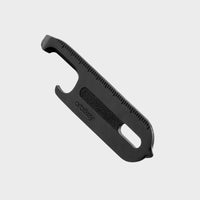
Are you looking to develop your green thumb in your downtime while you work from home? We are here to help with some tips on how to get started, ways to care for your greenery and even tricks to revive an overwatered plant.
For our very first Q&A session, we have Melbourne-based plant designer and stylist Ryan Klewer – the mastermind behind our luscious green wall at Orbitkey HQ. In 2019, Ryan founded Plant Charmer – a plant design studio combining organic material and the human environment; bringing nature into interior spaces.

1. What are some of your recommendations for low maintenance indoor plants?
Some of my most favorite indoor plants are low maintenance ones! When you live a busy lifestyle, sometimes it’s hard to find time to take care of your plants. Luckily, some species are a tad more forgiving.
But before I go into listing them, I just wanted to add that regardless of how difficult the plant might or might not be to take care of, understanding the basics of plant care will give you the tools to take care of all of them! I’ve created a maintenance guide that provides information on what these fundamentals entail and tips on how to achieve them. Ok, back to the question!
My top 3 low maintenance plants would have to be Pothos ‘jade’ (Epipremnum pinnatum) for its toughness, but also its vigor! This thing will grow like crazy! Next would be the rubber plant (Ficus elastica) due to its big, beautiful leaves. These guys come in a range of colour variations as well (ruby, lemon lime, Burgundy, tineke) to suit everyone's tastes.
They can also grow into quite large indoor trees which are an amazing feature in any home. Lastly, the fruit salad plant (Monstera deliciosa) is an all time favorite. Those large glossy fenestrated leaves are hard not to fall in love with!

2. I have a dying string of pearls. How can I revive them?
String of pearls are succulent, meaning they store a lot of water in their leaves. When they are overwatered, the cells in their leaves try to absorb as much water as they can and will rupture. This is a common cause of death for most succulent species.
They prefer a well draining sandy soil and prefer a well lit space. The more light the better. So a north facing window that doesn’t get direct sunlight during the day (morning sun is fine) will be your best bet!
3. How to keep track of all the different plant watering schedules?
This can be tricky! Especially if you have a lot of plants and they all require different water requirements. The way I have done it at home and with my job is to get them all within the same watering window, where I can water 90% of them on Wednesday and Thursday for example.
I’ve created a plant maintenance guide to help me keep track of this schedule and it’s also free to the public! It’s available to download from my website plantcharmer.com.au

Maidenhair ferns are suckers for humidity! In the wild, you will often find them calling a rocky outcrop next to a waterfall home. Bathrooms and kitchens offer up a more humid environment in most homes, making them an ideal place to keep them.
Placing the pot on a tray of pebbles with water in it will help to increase the humidity around the plant. Keep the soil moist, but not saturated. They don’t enjoy dry soil. They also like bright, indirect light. An east facing window is ideal for these guys!

5. What are some resilient and low maintenance indoor plants, particularly with toddlers? / Any easy maintenance plant that a toddler could help look after?
Most plants are susceptible to damage when treated roughly. Leaves will get ripped, stems broken. With toddlers around, it’s probably unavoidable! A plant like the devils ivy or Philodendron hederaceum (often called philodendron cordatum) are very easy to propagate, so if your young one does happen to break it, you can place it in a glass of water and watch together as the roots grow! It’s a very rewarding experience.
6. How do you take care of Fiddle Leaf fig? Our one always ends up with a yellow dried look on the tips of the leaves!
The Fiddle leaf has been the rock in the boot for many indoor gardeners. We often think we know what’s wrong with it, but can’t ever make it happy and healthy! The key to growing a large, luscious fiddle is consistency! They liked to be watered a particular way, on a set schedule. They don’t like to be moved around; they hate drafts.
Start off by placing your fig in a well lit room. The brighter the better! They can tolerate morning sun (they can actually handle full, direct sun, but need to be slowly acclimatised) but I would advise against letting it get midday or afternoon sun. Before you water them, you want to make sure that the soil is completely dry.
If you place your index finger into the soil up to your second knuckle and feel any moisture at all, delay watering for another day. Once it has dried out, place the plant somewhere that you can liberally water the entire surface area of soil until water starts coming out of the bottom of the pot.
Take note of this day and check your plant the following week. If it’s still moist, don’t be tempted to water it. The size of your plant, the soil and it’s available light will determine how much water the plant uses. Finally, every time you water your plant, be sure to gently dust each leaf with a damp cloth and keep an eye out for any pests!
7. I am trying to find out why some Monstera Deliciosa have more holes than others. Can you tell?
Great question! There are a number of theories behind this. One is that the holes ( or fenestrations to those in the biz ) act as a measure to prevent leaf damage during tropical storms, which are common in the regions of South Mexico in which they naturally inhabit.
The second is that they help allow water flow down their stems to their roots. Being an epiphyte (means they tend to grow on other larger trees) most of their root system Is above ground. Lastly and most likely to be the most plausible is that by creating these holes, the leaf can actually be much larger.
This helps capture the minimal amounts of light that gets through the rainforest canopy and into the underscores where these guys tend to live. As your plant matures, the size and shape of the leaves will change.

8. Where did the name Plant Charmer come from and should we be worried?
Hahaha! No need for alarm! It actually came to life when me and a good friend of mine were brainstorming names. He actually came up with it! When I talk to plants, good things happen.
9. Why does my dog eat my umbrella plant?
I’m not quite sure why your dog does this, but I suggest putting the plant out of biting range. Perhaps purchase a plant stand and place the pot on top of it.
10. Where can we get affordable indoor plants from?
There are a lot of pop-up plant sales around the nation at the moment. Generally you can go to them and pick up a pretty great deal. A lot of shops are now transitioning to online because of Covid-19 and are offering discounts and free postage. Local nurseries are also a great place to pick up a few plants, as is Facebook marketplace and gumtree.
11. Where do gnats come from?
Gnats live and breed in soil. They can be brought into your home either by bringing in plants that have them, or in soil you buy from the shops. They won’t actually really harm your plants unlike most of the other common pests. The best way to deal with them is to purchase some yellow sticky traps from your local nurseries or Bunnings and place them near the affected plant/s. It won’t kill them all, but it will reduce the population down considerably.
12. Are there indoor plants that are dangerous for pets?
A lot of indoor plants are actually toxic to pets, varying in toxicity. Most palms and calatheas are safe for your pets, as well as cast iron plants, pileas, birds nest ferns and spider plants.
13. Due to COVID-19, thinking of starting to garden. Can you give plants that have long shelf life?
If your focus is on indoor gardening, you will find that they all have a very long shelf life if cared for adequately. I suggest starting off with something hardy like a snake plant, or a ZZ plant. They require a lot less attention than most other plants. Infrequent watering and a bit less light don’t stress these guys out too much.

14. Where should I start from? (I want to get into plants but only got a small space)
The best place to start is determining how much light your space gets. Is there a window? Which way does that window face? Is it impeded by a building or trees? Once you understand the light levels, you can then decide on which plant will suit your space best. If the window is north facing and you get lots of direct light, you can have succulents and cacti right up against it. You can then place plants that require bright, but indirect light (no sun actually touching the leaves) such as philodendrons and ficus a few feet away from the window. If your window is obstructed or south facing, you will need to choose plants that can handle lower light conditions. These include peace lilies, devils ivy, snake plant, ZZ plant and rhapis palms.
15. My plant has white fuzzy mold on it. I wiped it off but it kept coming back. Help!
If it’s mold, I suggest moving the plant somewhere there is more airflow to help dry it out. It could also be mealy bugs that look like fluffy white lumps. Their eggs look like cotton wool and the bug itself looks white and fuzzy and a pill like shape. If it is mealybugs, get a cotton swab, dip it into some methylated spirits and dab all of the white lumps. Repeat this a few times over the next couple of weeks to kill the population. Look under every leaf and where the branches meet the main stem. These suckers are great at hiding!
16. How do you know when to increase the pot size? Also any hacks for pot drainage that doesn’t flow out onto the floor for pots without saucers. Always struggle with this!
The only time you should be re-potting your plants is when the pot is hard due to there being too many roots and there are roots coming out of the bottom of your pot. If you can pull the entire plant out of the pot soil included, it’s time to upgrade.
Now, I tend to only do this towards the end of winter, as you don’t want to disrupt the plant during the growing season (Spring and Summer). If it’s dire, you can do it outside of this window. Only re-pot up one size at a time and tease the roots a little to encourage them to grow into the fresh soil. To avoid spillage, I suggest placing the plant inside of the decorative pot still in its plastic pot.
That way you can put a plastic tray underneath it inside of the decorative pot. The other option would be to seal up the hole using silicone, then add a 2-3cm layer of pebble and horticultural charcoal to act as a drainage layer, then plant on top. This is only suggested if you have a lot of experience with plant care, as it’s very easy to overwater and rot the roots.
Our Q&A session is a fortnightly initiative, where we collaborate with some of our favourite creatives to share engaging content that we hope will inspire you.
Follow us on Instagram @orbitkey to stay up to date with new announcements and to submit your questions for our next Q&A.
If you would like to see more, stay up to date by subscribing to our newsletter below.























